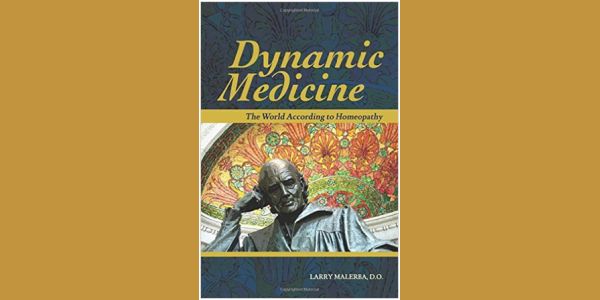First Edition – Dec 2016
Maverick Press – Altamont NY
Paperback 262 pages
$17.95
ISBN-10: 0998013404
ISBN-13: 978-0998013404
“This book is my attempt to convey to you, the reader, an understanding of the world as seen from a homeopathic perspective. My intention is to help you wrap your mind around the science, art, and mystery that is homeopathy. And believe me, while homeopathic methodology is indisputably scientific, and its practice requires an artful touch, the explanation for its remarkable power to heal remains a mystery, even to those who’ve successfully used it for years.” – Larry Malerba
Dynamic Medicine: The World According to Homeopathy” by Larry Malerba, DO, is a thoroughly engaging, contemporary exploration of health and disease through the eyes of a homeopath. He uses an easy-to-read, conversational style to share his journey and insights into the homeopathic profession, yet conveys a breadth and depth that few other books on homeopathy can offer.
As a homeopath and osteopathic physician, Malerba offers a unique perspective on homeopaths and patients living in a world of conventional (allopathic) medicine. His reflections provoke readers to think on their own, and in the spirit of exploration, he clearly prefers critical thinking over simple conformity with what he or any other authority might have to say. Readers can open the book to nearly any page to find new and thought-provoking observations about homeopathic practice.
In the early chapter “Who Seeks Homeopathic Care and Why?” Malerba describes many of the reasons and conditions for which people seek homeopathic care, including disillusionment with conventional medicine. He shows how homeopaths treat each person as an individual–an individual experiencing a broad range of characteristic symptoms–and not just common symptoms limited to a particular diagnosis. The chapter Homeopathic Psychology also discusses the significance and use of psychological symptoms in homeopathic assessment.
The True Nature of Health and Healing describes the broader principles of homeopathic healing, and Malerba points out how homeopathy’s greater context for interpreting responses to treatment–improved mood, energy, sleep, etc.– is (shockingly) absent from conventional medicine. And the wide range of successes in Case Histories from his personal practice provides a glimpse into the incredible healing potential of homeopathy. The chosen remedies for each of these vignettes are listed in the back of the book, allowing homeopaths to test their own diagnostic skills before reading the solutions.
The chapter “How We Get Sick and Why” provides a clear overview of how illness is understood and addressed in homeopathic vs. conventional circles. And recognizing that most homeopaths have experienced challenges explaining homeopathy to others, the chapter “How to Explain Homeopathy? Let Me Count the Ways” is an accessible and deep discussion of the most common theories underlying the mechanism of action of homeopathic remedies.
The tone of this book is even-handed throughout, but Malerba has little patience for skeptics who attack homeopathy without any experience–those who are more invested in “scientism” than true scientific inquiry. And while he isn’t interested in arguing with closed minds, “Common Misconceptions” is an excellent point-by-point rebuttal of flawed, theoretical arguments against homeopathic practice.
The Revolutionary Nature of Homeopathic Healing also provides a summary critique of contemporary medical practice compared to homeopathy, and Malerba paints a stark contrast between the limitations of the allopathic model, and the great potential offered through homeopathy. Finally, the Appendix of Practical Homeopathic Tips is a useful guide for those new to homeopathy, and includes suggestions on how to find a qualified homeopathic practitioner, how to continue interacting with allopathic practitioners, and how to benefit from both.
Dynamic Medicine: The World According to Homeopathy has become my favorite book to recommend for those who, regardless of experience, are interested in a deeper understanding of homeopathic/energetic medicine vs. allopathic/ materialistic medicine. If you’re unfamiliar with homeopathy and energetic medicine but interested in learning more, this book may well turn what you’ve always believed about health and disease on its head. And even if you’re familiar with homeopathic practice and remedies, Malerba’s deep reflections–clearly borne of experience–will stretch your personal understanding of this mysterious healing modality called homeopathy.
“In the final analysis, I believe that the best of all medical worlds–homeopathic, allopathic, and all other holistic healing systems–must be synergistically combined in order to minister effectively to the sick and suffering. With that said, oftentimes the best and most effective first line of defense is homeopathy.” – Larry Malerba







Thanks, David, for this nice and detailed book review about an obviously well written and recommendable book written by Larry Malerba.
Best regards,
Katja